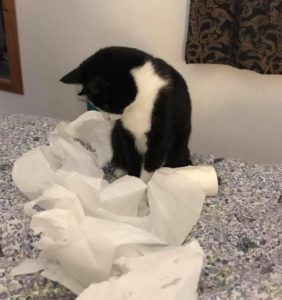
Cat age: 7 months – 2 years
Human equivalent: 7-24 years
Not quite a kitten anymore, but there is still a lot of growing to do! Cats in this age group, like adolescents and teenage children, are all about pushing boundaries and learning from the consequences. Be prepared for the mood swings that come as a result…
Recommended Veterinary Care
| What needs to be done? | How often?* |
| Health check/physical exam | Every 6-12 months |
| Weight check | Every 6-12 months |
| Vaccination | 1 year after kitten series, then every 1-3 years based on individual risk assessment |
| Worming | Every 3-12 months as required by lifestyle |
| Flea treatment | Monthly, if you choose to treat, otherwise flea comb monthly |
| Nail trim | Not recommended for young cats that go outdoors |
| Blood pressure check | Not required at this age |
| Urine test | Not required at this age |
| Blood test | Not required at this age |
| Neutering | ASAP, if not done already |
| Microchip | ASAP, if not done already |
| Pet Insurance | If you would like to insure your cat, do so on the day you bring them home |
*Please note, recommendations may differ between vets and there isn’t necessarily a right or wrong answer, these are just our suggestions based on our desire to keep our cats safe but avoid over-treatment at the same time!
How You Can Help At Home
Allow them the freedom to exercise and explore
- Cats of this age are extremely active. If you live in a relatively quiet location, allowing them outdoor access is a great way to ensure they get the exercise their bodies need. If outdoor access isn’t an option there are many resources online to help with creating a fun indoor environment including the Indoor Pet Initiative at indoorpet.osu.edu/cats.
- For any cat with outdoor access, a microchip-activated cat flap is recommended. This will both allow them freedom of movement but also safe entry back into the house if they find themselves chased by another cat. Microchip cat flaps keep other cats from entering your house, an extremely distressing situation for your naturally territorial cat.
- If your cat is going outside, now is the time to begin regular flea and worm preventative treatments
Keep them entertained

- Just like bored children acting up, frustrated cats may display behaviours which we find unacceptable such as scratching at the furniture or climbing the curtains. Outdoor access is likely the best way to provide your cat with the freedom and intellectual stimulation they require however again you can create a suitable indoor environment if needed.
- All cats benefit from an enriched indoor environment including wide, tall and stable scratching posts, catnip toys, feather wand toys, suitable resting places including both enclosed and up high options. For cats without outdoor access, you will have to work a bit harder to provide your cat with the freedom and intellectual stimulation they require. There are many resources online to help with creating a fun indoor environment for all cats including the Indoor Pet Initiative at indoorpet.osu.edu/cats.
Keep them safe
- Be very mindful of household hazards and do your best to keep these to a minimum. That means no lilies in the house, full stop! Other common hazards include household cleaners, potpourri, essential oil diffusers, many human foods and all medications.
- Never use topical products on your cat unless specifically recommended by your vet. Medications used on dogs are often not safe for cats, and topical products such as TCP, Germolene, Savlon and tea tree oil can be toxic for cats, even at low doses.
- If your cat wears a collar, make sure it has a safety release and that you adjust it regularly as they grow.
Feed a high quality diet

- Remember that cats are strict carnivores – they are built to eat other animals or in other words, meat. Although most cats can tolerate grains and starchy foods to some extent, some cannot. Unless your vet has specifically recommended a particular diet for medical reasons, you are generally safe to feed your cat the highest meat content food you can afford and avoid foods with a lot of grains (carbs) or fillers (NOTE – ‘grain-free’ does not necessarily mean high in meat so check the ingredients list carefully).
- In general, wet foods are closer to the natural diet of a cat than dry foods and also help prevent dehydration so they are usually a better choice for the majority of your cat’s diet.
- Make sure most of the food you feed your cat says it is ‘complete and balanced’, as feeding too many ‘complementary’ foods can result in dietary imbalances.
- Meat is the most expensive component of any pet food so unfortunately the best foods for your cat are often the most expensive. Can’t afford top quality cat food 7 days a week? Mix and match, or supplement their diet from time to time with a high quality protein sources such as plain cooked chicken or fish.
- Learn which foods your cat prefers and avoid those that regularly cause stomach upset as what works for one cat may not work for another.
- Always make sure your cat has access to fresh water, even if they don’t seem to want to drink it. Cats don’t usually like to eat near where they drink, so separate their food and water dishes.
Maintain good habits
- Continue to practice brushing their teeth, clipping their nails and brushing their coats while they are young to avoid stress later in life. Be respectful of their decreasing tolerance however and don’t force the issue if they regularly object.
Good To Know
Young cats are naturally curious so if your junior cat is hiding away all the time, speak with your vet.
Most young cats love to hunt. If your cat has outdoor access, be prepared to accept their little ‘gifts’. If this thought terrifies you, keep your cat indoors from dusk till dawn as this is when most hunting occurs.
Many cats may prefer to urinate and defecate outdoors but some prefer the comforts of home. Even if your cat rarely uses a litter tray, it is best to keep one in the house (in a quiet, safe area) so they have the option of using it if needed. Changes in urination/defecation can also indicate health problems so maintaining a litter tray is a great way to keep track of what they are producing. Remember that your cat is bigger now so you may need to upgrade to a larger tray size.
Cats have a tendency to put on excessive weight after they have been spayed/neutered due to a drop in metabolism, especially if they are allowed free access to food at home. This is NOT normal however, nor is it healthy for them, and you can help prevent excessive weight gain by feeding a healthy, high meat-content diet in a reasonable quantity at a reasonable frequency. Food package guidelines can help but remember, every cat is an individual and you need to find what works for your cat – ask your vet nurse for advice!

Cats of this age may go through a bit of a personality change, the ‘moody teenager’ effect if you like. It may even seem like all of your hard work socialising them as a kitten has been forgotten sometimes. Don’t get too discouraged though, they often come out the other end of it more relaxed around the age of 2-3 so be patient and keep working with them to encourage positive behaviour and discourage inappropriate behaviour.
Junior cats may also experience changes in their relationships with other cats in the family. Siblings who used to play all day and curl up together may choose to spend more and more time apart or simply dislike each other as they get older so be prepared to find ways of offering each cat their own space within the home environment as they mature. Cats are generally solitary creatures by nature so although this can be distressing to watch, it is usually just part of growing up.
Junior cats may start to express stronger food preferences. While it is great to feed them their favourite foods sometimes, don’t fall into the trap of feeding them JUST their favourite food all the time (think teenagers at a fast food restaurant), especially if that is a dry biscuit, because maintaining a high quality varied diet is important for lifelong health as it protects them from dietary imbalances. They may happily eat one type of food one day, then turn their nose up at it the next. Don’t get angry or give up, simply put the rest of that variety in the cupboard and try again in a few weeks, chances are they’ll try it again later.
For cats that are allowed outdoors, this is when they learn how to interact with neighbouring cats, for better or for worse. Although they tend to start out running away from trouble, as they gain confidence in their new environment you may notice them starting to come home with scratches and bites from fighting. Monitor these closely and contact your vet if you have any concerns.
It is normal and essential for cats to scratch things with their claws in order to keep their nails at a healthy length and as a sign of territory marking, much as they would learn to do in the wild. If you don’t want that ‘thing’ to be your sofa, provide a wide variety of scratching posts of different materials and sizes for your cat to choose from.
Although young kittens don’t often take much notice, junior cats may start to enjoy catnip – it’s a great way to encourage both exercise and relaxation so bring it on!
This guide is based on the AAFP-AAHA Feline Life Stage Guidelines publication, as well as recommendations made by the ISFM CatCareforLife and iCatCare websites – please visit these highly informative websites for additional information.

